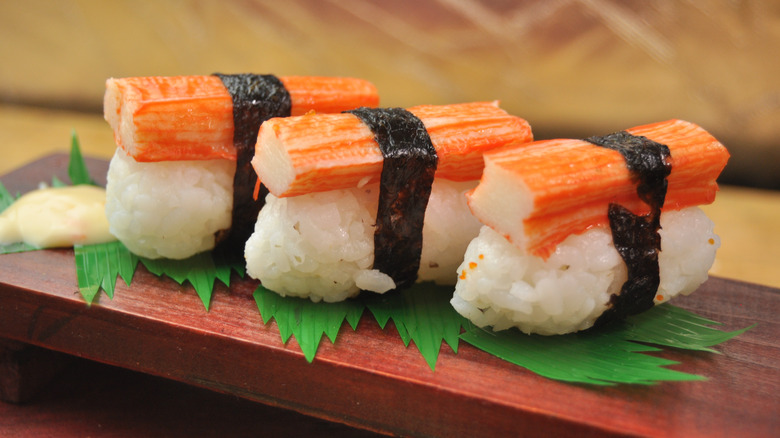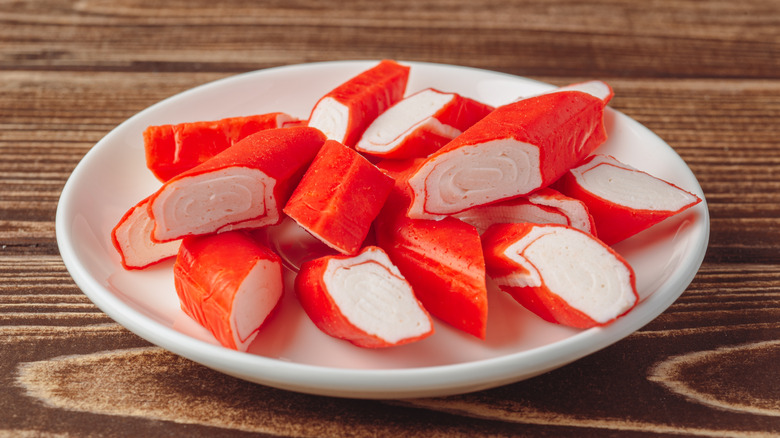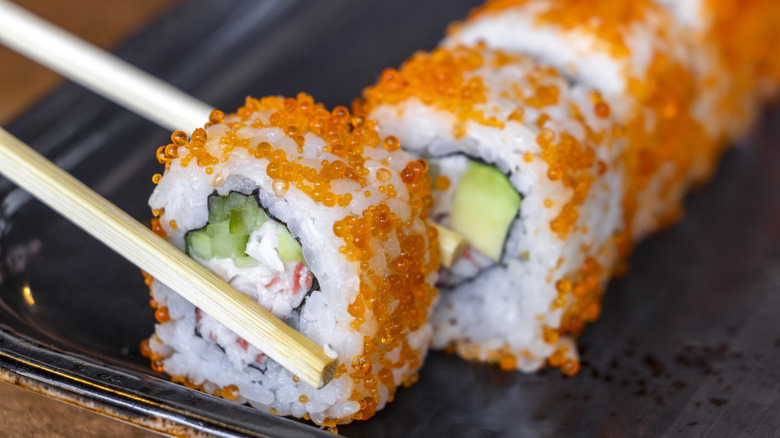What Imitation Crab Is Really Made Of (And Why It Tastes Similar)
Just how much of an imitation is imitation crab? Well, it depends on how you look at it. First and foremost, imitation crab does not contain any crab. However, it is made from seafood. This crab analog largely consists of a paste called surimi, primarily made of white fish that dwell near the ocean floor, such as haddock, Atlantic cod, and Alaskan pollock. To create imitation crab, surimi is bound together with starch and egg whites so that it can hold its shape. The exterior is then dyed with orange food coloring to emulate the look of cooked crab.
Imitation crab was first created in Japan in the 1970s as a cost-effective alternative to expensive crab. It made its way across the Atlantic to America a decade later, where it grew in popularity. Today, it is commonly used in sushi, salads, and fast-food seafood sandwiches. In America, it is often called "kani," which is the Japanese word for crab. It tastes similar — but not identical — to crab, with a mild seafood flavor reminiscent of the white fish from which it's made.
Imitation crab vs real crab
Imitation crab shares some flavor notes with real crab, as both have an oceanic, briny taste. Sometimes crab extract is added to enhance this flavor in kani. However, the imitation is much saltier than the real deal, a result of additional sodium added when mixing the surimi. Real crab is also sweeter, with a more delicate flavor.
Kani has a very different texture from real crab. Imitation crab is more rubbery, and does not flake the same way the genuine article does. Additionally, the two foods have different nutritional values. Real crab is richer in vitamins and minerals like vitamin B12 and zinc, and derives its calories from proteins, while kani gets its calories from carbs.
Regarding those carbs, another significant difference is that imitation crab isn't gluten-free. This is due to the starches mixed with the surimi to help the imitation crab maintain its shape. Therefore, if you are gluten sensitive or following a diet like keto, imitation crab should be avoided.
Imitation crab is, however, significantly cheaper than real crab and arguably more convenient, as it is ready to use, and does not require the cooking and shelling associated with whole blue crabs.
When to use imitation crab
Because of their differences, imitation crab is best used as its own unique ingredient, rather than as a direct substitute for crab. Perhaps the most famous dish featuring imitation crab is the California roll, which helped popularize sushi in America during the 1970s and 1980s. This dish is a popular choice for home preparation as well, because it doesn't require expensive ingredients or raw fish. Instead, it relies on imitation crab, cucumber, and avocado for its filling.
Another common dish at sushi restaurants is kani salad, where shredded imitation crab is tossed with julienned vegetables like cucumber and mixed with mayo. For the best results, use Japanese kewpie mayo, which is sweeter than most Western versions and has an added savory kick from MSG.
Imitation crab is also a key ingredient in crab rangoons, where the delicate flavor of crab is largely overpowered by cream cheese, leaving just a hint of briny flavor. In this context, imitation crab is a sufficient substitute for the real thing, allowing you to achieve similar results on a smaller budget. This is worth trying in recipes like spicy Cajun crab rangoons.



